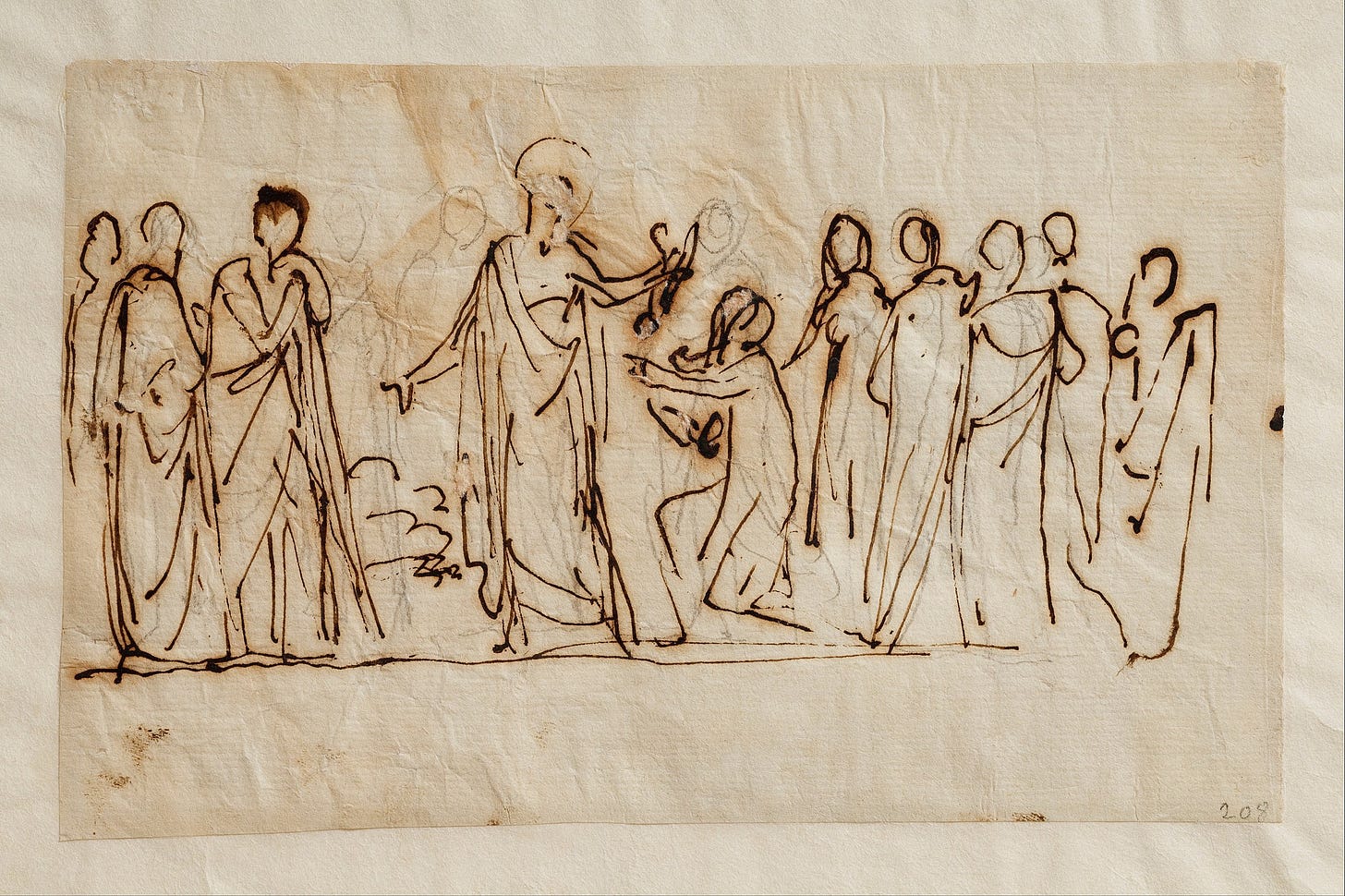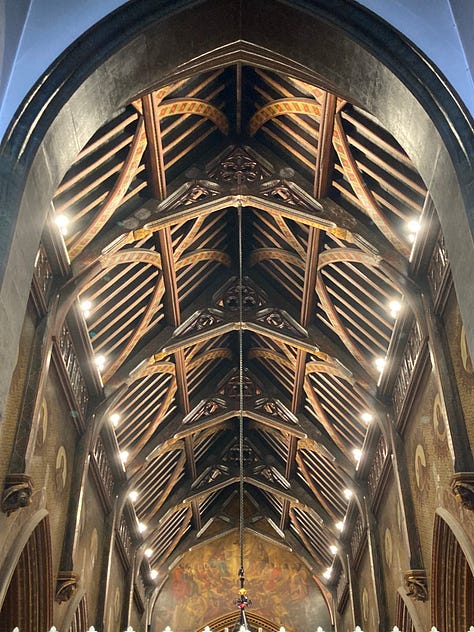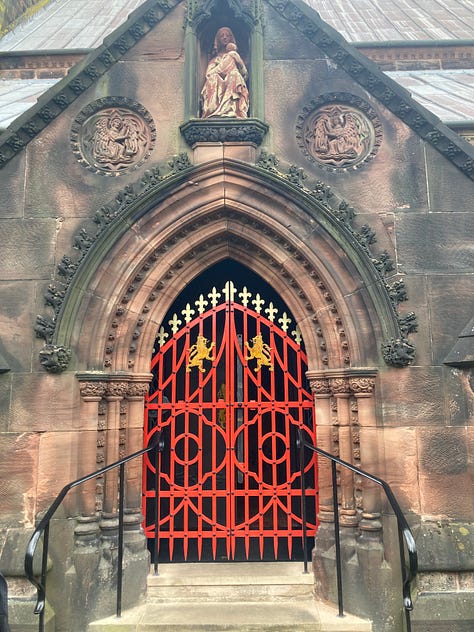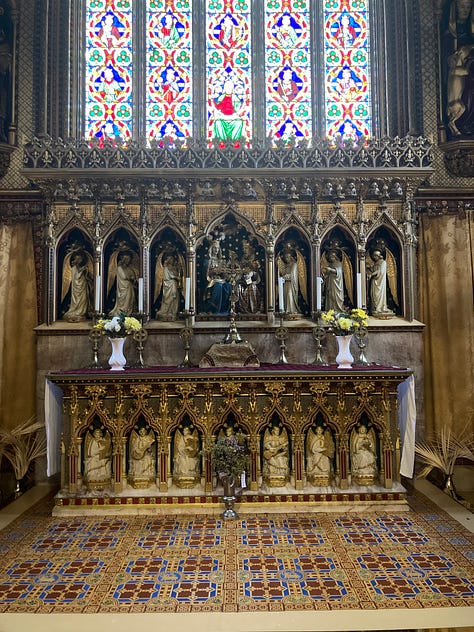The heresy of “Solo Papa”; Cultural elite stands up for TLM; and more
Today’s post is free for everyone to read. All the same, I hope you will consider taking out a paid subscription to help Julian and me continue what we are offering here, and to access the exclusives! ~ PK
Clipping the wings of a runaway papalism
I did two interviews this past week — one with the esteemed apologist Erick Ybarra of Classical Christian Thought, and the other with Kennedy Hall of a “sister Substack,” Mere Tradition.
Erick and I have known each other for several years. We first butted heads on social media when he was more of a (hyper)papalist. I always learned from his articles and posts. We finally met one day for lunch in Wisconsin and had a good conversation. In the intervening years Erick’s study of the role of the pope in church history has convinced him that an extreme papalism — what might be called solo papa, short for “we know the truth/the Faith by the pope alone,” with its corollary “we must always do as the pope bids” — is untenable and in fact contradictory to other constitutive elements of Catholicism, no less than sola fide or sola Scriptura is. (In point of fact, there is a subterranean connection between Protestantism and hyperpapalism, as I demonstrated last November in this Substack post).
It was therefore a special joy to me that we were finally able to meet and have a leisurely conversation on this topic, paying particular attention to the epistemological difficulties of the hyperpapalist position and the reason why it is wrong to label as “Protestants” those Catholics who, for serious reasons — e.g., knowledge of prior truths or more authoritative teachings, or even the requirements of basic logical consistency — question or reject a non-infallible teaching of the pope. You can watch it here:
Kennedy, for his part, I’m sure needs no introduction. Our conversation centered on the ways in which the pope is subordinate to canon law; on the debate between Lamont and Ureta concerning how episcopal jurisdiction arises, and the reason one might agree with Francisco de Vitoria that a bishop receives his jurisdiction from Christ upon consecration, not from the pope who appoints him to a see; historical examples of bishops resisting popes and even consecrating bishops without a mandate; why Lefebvre was neither a schismatic nor had a “schismatic mentality”; and the rumors of new bishops for the Society.
Cultural elite stand up for the TLM
The biggest news this past week was the surprise release of a statement on the 3rd of July in The Times of London, signed by 48 eminent persons from the UK — peers and cultural figures — in defense of the Traditional Latin Mass. The signatories are a remarkable “Who’s Who” in Great Britain: Bianca Jagger, Lord Lloyd-Webber and Julian Lloyd-Webber, Dame Kiri Te Kanawa, HRH Princess Michael of Kent, Sir Andras Schiff, author Tom Holland, Lady Antonia Fraser, Sir Nicholas Coleridge, Sir Paul Smith, Dame Mitsuko Uchida, Sir James MacMillan, and many others (more or less recognizable to your average American reader).
The statement expressly harks back to the “Agatha Christie” petition published in the same newspaper in 1971, which led to the “indult” (which was never necessary, we now know) for England & Wales by which the old Mass kept a foot in the door, so to speak, before the loosening of restrictions under John Paul II and finally Benedict XVI. We can, in fact, predict a similar loosening of restrictions after this abysmal pontificate ends and the irrational campaign against tradition subsides again, as it is bound to do with the changing of the guard.
Here’s the statement and its sparkling signatories:
On July 6, 1971, The Times printed an appeal to Pope Paul VI in defence of the Latin Mass signed by Catholic and non-Catholic artists and writers, including Agatha Christie, Graham Greene and Yehudi Menuhin. This became known as the “Agatha Christie letter”, because it was reportedly her name that prompted the Pope to issue an indult, or permission, for celebration of the Latin Mass in England and Wales. The letter argued that “the rite in question, in its magnificent Latin text, has also inspired priceless achievements ... by poets, philosophers, musicians, architects, painters and sculptors in all countries and epochs. Thus, it belongs to universal culture.”
Recently there have been worrying reports from Rome that the Latin Mass is to be banished from nearly every Catholic church. This is a painful and confusing prospect, especially for the growing number of young Catholics whose faith has been nurtured by it. The traditional liturgy is a “cathedral” of text and gesture, developing as those venerable buildings did over many centuries. Not everyone appreciates its value and that is fine; but to destroy it seems an unnecessary and insensitive act in a world where history can all too easily slip away forgotten. The old rite’s ability to encourage silence and contemplation is a treasure not easily replicated, and, when gone, impossible to reconstruct. This appeal, like its predecessor, is “entirely ecumenical and non-political”. The signatories include Catholics and non-Catholics, believers and non-believers. We implore the Holy See to reconsider any further restriction of access to this magnificent spiritual and cultural heritage.
Robert Agostinelli; Lord Alton of Liverpool; Lord Bailey of Paddington; Lord Bamford; Lord Berkeley of Knighton; Sophie Bevan; Ian Bostridge; Nina Campbell; Meghan Cassidy; Sir Nicholas Coleridge; Dame Imogen Cooper; Lord Fellowes of West Stafford; Sir Rocco Forte; Lady Antonia Fraser; Martin Fuller; Lady Getty; John Gilhooly; Dame Jane Glover; Michael Gove; Susan Hampshire; Lord Hesketh; Tom Holland; Sir Stephen Hough; Tristram Hunt; Steven Isserlis; Bianca Jagger; Igor Levit; Lord Lloyd-Webber; Julian Lloyd Webber; Dame Felicity Lott; Sir James MacMillan; Princess Michael of Kent; Baroness Monckton of Dallington Forest; Lord Moore of Etchingham; Fraser Nelson; Alex Polizzi; Mishka Rushdie Momen; Sir Andras Schiff; Lord Skidelsky; Lord Smith of Finsbury; Sir Paul Smith; Rory Stewart; Lord Stirrup; Dame Kiri Te Kanawa; Dame Mitsuko Uchida; Ryan Wigglesworth; A.N. Wilson; Adam Zamoyski
The organizer, James MacMillan, is one of Great Britain’s most prominent composers, the recipient of many awards and commissions, and a faithful Catholic who has written music for his local parish and spent countless hours coaching young composers to carry on the great tradition of Western art music. He composed a Mass for the visit of Pope Benedict XVI to England. He is “salt of the earth” as they say, but also very well connected!
What is the significance of such a statement? There is much one could say but very basically it is this: the educated and the influential, even in the secular world, recognize the enormous value of the most ancient, most continuous, and most prominent of all Western services of divine worship; they recognize its indisputable place in the history of the world and in the lives of many Christian believers today; they see its unsurpassed record for inspiring cultural masterpieces. And, what is most important, they cannot see any good reason why a religion should try to suppress it.
Now, you may ask: What difference could this make at the Vatican? On the one hand, the Church is not being ruled at this time by men who are notable for cultural sophistication or even basic awareness of the rules of polite discourse, so it’s not clear that the names of artistic and political worthies will land much of a blow on plans to further suppress the Church’s traditions (or, more likely, to die trying). On the other hand, we have to recognize that public opinion does count for something at the Vatican. There are always courtiers with their fingers in the air, feeling for the direction of the wind; and the pope himself — who, be it noted, loves Mozart and opera, and who would recognize at least the names of Sir Andras Schiff and Dame Kiri Te Kanawa, if no others — is not someone who totally ignores the way the winds are blowing. If causing shock and annoyance across the globe doesn’t fit in with the next moves of his Jesuitical chess game, he will refrain from doing it.
We must always bear the big picture in mind, as Joseph Shaw’s marvelous book The Latin Mass and the Intellectuals: Petitions to Save the Ancient Mass from 1966 to 2007 helps us to do (by the way, that was one of my favorite books in 2023, and I will no doubt mention it again). As the writers in that anthology show us, petitions signed over the decades by famous people, always in defense of the TLM, had very different outcomes: some were quite successful, others moderately so, others not at all. But that was less important that the constant witness that a series of public actions like this represents, and the subtle but real pressure they exert, both on ecclesiastical figures and on the broader culture. The Second Vatican Council called for an educated and active laity, and boy, have we got one now. (Better think twice before calling an end to clericalism!)
All of this is, I think, well captured in the article that Sir James MacMillan published in The Times simultaneously with the statement. I will give it here in full (with what is, to me, the “money quote” in boldface):
Traditional Latin Mass is a jewel that must be treasured
There are few more poignant experiences than attending the traditional Latin Mass — a religious celebration whose mixture of solemnity and intimacy leaves a profound impression on non-Catholics as well as Catholics.
Its ancient chants have inspired sublime music by Josquin, Palestrina, Byrd, Haydn, Mozart, Beethoven and Stravinsky. But it is also remarkable for its silences: the intricate actions of the priest, facing towards Jerusalem, are accompanied by whispered prayers — “the blessed mutter of the mass”, as Robert Browning described it. After the Second Vatican Council, which gave Catholics the freedom to worship in their own language, a faction in the Church tried to ban the traditional Mass completely.
That is why, in 1971, writers and creative artists including Agatha Christie, Vladimir Ashkenazy, Iris Murdoch and Ralph Richardson published an appeal to Rome in The Times. It became known as the “Agatha Christie letter” because, apparently, Pope Paul VI was so startled to see the name of the “queen of crime” that he allowed the old Mass to survive.
In the decades that followed, a growing minority of Catholics embraced the transcendental symbolism of this unchanging liturgy. In 2007, Pope Benedict XVI granted permission for its celebration wherever it met the needs of Catholics. It flourished. In 2021, however, Rome effectively banned the traditional Latin Mass from parish life.
This decision was a shattering blow to Generation Z Catholics who have found their spiritual home in the old liturgy. They are bewildered by the new hostility they face — but now it appears that worse is to come. Sources report that the Vatican is planning an almost total ban on the “Mass of the Ages”, as it’s known.
The fact that there are Vatican functionaries indulging in this petty, philistine authoritarianism against their own co-religionists is shocking for a non-Catholic audience. Fortunately, creative artists and other public figures are once more coming forward in defence of religious freedom via a letter to The Times. They include some wonderfully diverse and distinguished names such as Sir Stephen Hough, Bianca Jagger, A.N. Wilson, Lord Lloyd-Webber and Dame Kiri Te Kanawa.
The full list of signatories includes Catholics, Protestants, members of non-Christian faiths and non-believers. It represents a broad political spectrum and artists born 60 years apart. In the spirit of our common humanity, we appeal to the Holy See to restore to Catholics the precious freedom to participate in the glorious liturgy of their ancestors.
Thank you, Sir James!
When I needed to take a break from working on the index for my next book with TAN (I’ll talk about that when the time’s right!), I dashed off a little poem about our current situation:
His diktat was: “There must not be
A Latin Mass from sea to sea,
No eastward stance, no chant sublime—
Ye rebels, back to Ord’n’ry Time!”His fatwa next: “Let migrants come,
Let Muslims in, where’er they’re from,
Muezzins, mosques, let them arise:
Religious freedom we advise!”And lastly, his ukase befell:
“By my decree, I say that hell
Is empty, like a modern church
That breeding rabbits can’t besmirch—Except for one abysmal club
That richly earns th’eternal snub:
I mean the backwardists, who dare
To offer up the age-old prayer!”
Back to The Times statement: I recommend Joseph Shaw’s commentary on it, “The Cultural Elite Stands Up for the Traditional Mass.”
More generally, here are some other fine articles that have appeared since last week’s roundup:
Kevin Tierney, “The Game: What Now For the Traditional Mass Under Francis?”
Kennedy Hall, “Fair-Weather Traditionalism Is Over.” I’ve been beating this drum for a while, especially since Traditionis Custodes. In a time of confusion like this, we need to have REASONS behind our actions, instead of either just going with a “gut feeling” or cowering before threats and blandishments. Hall writes: “There is nothing wrong with the Catholic instinct that drives someone toward Tradition, any more than the aesthetic instinct that tells someone Gregorian Chant is better than Marty Haugen.... But instinct is not a strong enough argument for the troubles that lie ahead. Well, now that Tradition is under attack by a carpet-bombing regime, I think it is time that all trads dust off [...] volumes of Traditional apologetics. As the persecution ramps up, we will be forced to make hard decisions and [should] have sound reasons for those decisions. We must go beyond the panoply of podcasters who fill our earbuds and go straight to the sources. Fair-weather Traditionalism had its decade in the sun, and that time is over.”
Michael Brendan Dougherty, “The Undefeatable Prayer” (behind a paywall). His basic thesis: “The papacy may wield tremendous authority in the Catholic scheme of things. But I don’t think that even that office is capable of defeating the TLM and abolishing the traditional liturgy of the church. Why? Simply put: Pope Benedict’s argument for granting liberty to Catholics to attend the TLM is true, and comports with the deep truths of the faith. Pope Francis, in banning it, advanced a sociological argument that was untrue at the time he made it and proved more untrue in implementation. And then men around Francis who would ban it forever are advancing an argument that is revolutionary and counterintuitive in a self-defeating way.”
Luisella Scrosati’s latest column, “Reality is stronger than those who want to bury the Ancient Rite,” puts a finger on the basic hypocrisy that is so obvious to any knowledgeable Catholic that it instantly undermines any credibility the Vatican may have.
From Down Under: “Young Catholics defy Pope, choose Latin as rift grows in Australia’s biggest church.” My favorite bit: “Father Glen Tattersall, who led the Latin mass at St Patrick’s and continues to do so at St Aloysius, was more blunt in his assessment of the Pope. ‘I think he’s out of touch,’ Fr Tattersall said of the Pope. ‘I think he’s kind of typical of his age and background — he doesn't understand that we’re not stuck in the 1960s anymore. He’s talking a lot about ‘everyone is welcome in the church’, but I'm sorry to say that a lot of Catholics don’t feel very welcome at the moment in this pontificate.”
Do not forget that those who want to take away the TLM also want to take away your “reverent Novus Ordo” with chant, ad orientem, kneeling for communion, and the rest of it. The presence of the TLM at the diocesan level was helping to bring those traditional practices back — and the modernists are apoplectic about it. See my article “Why Restricting the TLM Harms Every Parish Mass.”
A beautiful collection of comments from “regular folks in the pews” about what the TLM means to them went up at Rorate Caeli (you can read it here). Reading these simple, sincere words would be enough to melt a heart of granite — unless it wants to stay hard.

The gates of hell
Over at The Remnant, Robert Morrison, for whom I have the greatest respect, has a longish piece entitled “Lefebvre, Viganò and the Post-Conciliar Struggle Against the Catholic Church’s Enemies.” Now, most of you I think are aware that I am not a big Viganò fan at this point. I once was, but he lost me somewhere between Covidtide and the last Trump election. Here is not the place to go into the details. I say this only to make it clear that I share this link as a thought-provoking piece, not because I agree with all of it. In particular, this paragraph struck me:
Our Lord’s promise that the Church would never fail is not a litmus test by which we need to evaluate whether Jesus was telling the truth: we know that He established the Catholic Church, and that it will not fail because He told us it would not. Moreover, He would not have had any real reason to tell us the Church would not fail if there would not be times (such as the Arian crisis and the current one) in which it might seem that the Church had defected.
This seems like an obvious point once you say it, but I think it’s important: the reason Jesus solemnly assured us His Church would not fail is that Satan’s assaults could, at least at certain times, be so persistent and powerful that it would look, to an observer, as if “there’s no way the gates of hell won’t prevail” (or indeed, that they haven’t already prevailed), “no way the barque won’t sink this time.”
Many times, reading the annals of church history, I have felt rise up within me an almost stomach-churning horror, dismay, bewilderment, or outrage, combined with a newfound amazement that the Church came through the fire intact, even purified. As a sympathetic reader I try to imagine what it might have felt like to be a Catholic living in the fourth century, or in the age of iconoclasm, or the saeculum obscurum (the first pornocracy), or the Great Schism, or the worst of the Protestant Revolt and the Wars of Religion, or the French Revolution… “This time, it’s over FOR SURE.”
And yet... it never is.
What is the moral? Ask for an increase in supernatural faith, hope, and charity. That is what gets any one of us through the worst of the worst that man — or demon — can devise. I’ll let the Apostle take it from here:
We know that to them that love God, all things work together unto good, to such as, according to his purpose, are called to be saints…. If God be for us, who is against us?… Who then shall separate us from the love of Christ? Shall tribulation? or distress? or famine? or nakedness? or danger? or persecution? or the sword? (As it is written: For thy sake we are put to death all the day long. We are accounted as sheep for the slaughter.) But in all these things we overcome, because of him that hath loved us. For I am sure that neither death, nor life, nor angels, nor principalities, nor powers, nor things present, nor things to come, nor might, nor height, nor depth, nor any other creature, shall be able to separate us from the love of God, which is in Christ Jesus our Lord. (Rom. 8:28,31,35-39)
This is what I hold on to, with an iron grip that never lets go.
Other news
To assist in the Eucharistic Revival, The Real Presence Coalition has been launched to highlight the causes of lack of faith or deformed faith in the Eucharist and to gather information on what believing Catholics think would make a difference. I am part of it, along with these other folks:
Please, take a few moments to complete the survey we have created:
https://www.surveymonkey.com/r/realpresence
A Shepherd Solicitous for the Whole Church
Check out this short video introducing the book of interviews with Bishop Athanasius Schneider that Os Justi Press just released:
And, as always, something beautiful for your soul
A priest friend sent me photos of a church he visited a few days ago: “Pugin’s Gem” in Cheadle, UK. Now I share them with you. Deo optimo maximo: To God, the greatest and best.








Till Monday… Thank you for reading, and may God bless you!





A very helpful article, particularly on the heresy of “Sola Papa.” Geoffrey Hull’s excellent historical analysis in “The Banished Heart,” and especially, his explanation of the Jesuit’s contribution to the development of papal absolutism was an eye-opener for me with regard to the permanent feature of “absolute and mindless obedience” in the Latin Church. Hull first clarified for me how our modern papal confusion (on the part of the faithful) might have begun. Thank you again for this piece.
It was interesting yo read that you spoke with Kennedy Hall. I wonder what you think of Kennedy Hall's youtube offerings about the Charismatic movement, and in particular about Ralph Martin, the Companions of the Cross etc.
While I am not a fan of the Charismatic movement, and have wondered about the Baptism in the Holy Spirit, I find Hall's videos one sided.
Do you have an opinion on his take? On Twitter, Hall was surprised he was blocked by Rorate
Caeli. Aren't you the editor of Rorate Caeli?